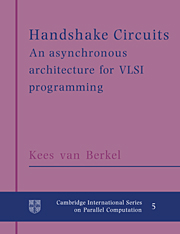Book contents
- Frontmatter
- Contents
- Foreword
- Preface
- 0 Introduction
- 1 Introduction to Tangram and handshake circuits
- 2 Examples of VLSI programs
- 3 Handshake processes
- 4 Handshake circuits
- 5 Sequential handshake processes
- 6 Tangram
- 7 Tangram → handshake circuits
- 8 Handshake circuits → VLSI circuits
- 9 In practice
- A Delay insensitivity
- B Failure semantics
- Bibliography
- Glossary of symbols
- Index
1 - Introduction to Tangram and handshake circuits
Published online by Cambridge University Press: 14 January 2010
- Frontmatter
- Contents
- Foreword
- Preface
- 0 Introduction
- 1 Introduction to Tangram and handshake circuits
- 2 Examples of VLSI programs
- 3 Handshake processes
- 4 Handshake circuits
- 5 Sequential handshake processes
- 6 Tangram
- 7 Tangram → handshake circuits
- 8 Handshake circuits → VLSI circuits
- 9 In practice
- A Delay insensitivity
- B Failure semantics
- Bibliography
- Glossary of symbols
- Index
Summary
This book pursues a programming approach to the design of digital VLSI circuits. In such an approach the VLSI-system designer constructs a program in a suitable high-level programming language. When he is satisfied with his program, the designer invokes a so-called silicon compiler which translates this program into a VLSI-circuit layout.
The choice of the programming language is a crucial one, for it largely determines the application area, the convenience of design, and the efficiency of the compiled circuits. A good VLSI-programming language.
0. is general purpose in that it allows the description of all digital functions;
1. encourages the systematic and efficient design of programs by abstracting from circuit, geometry and technology details;
2. is suitable for automatic translation into efficient VLSI circuits and test patterns.
Below follows a motivation for these requirements.
0. A wide range of applications is required to justify the investment in tools and training.
1. A major gain in design productivity can be expected by designing in a powerful highlevel language. Furthermore, system designers do not need to resort to VLSI specialists. Systematic design methods, supported by mathematical reasoning, are required to deal with the overwhelming complexity involved in the design of VLSI systems.
2. Automatic translation to VLSI circuits avoids the introduction of errors at the lower abstraction levels. It also becomes attractive to design alternative programs and compare the translated circuits in costs (circuit area) and performance (speed and power).
- Type
- Chapter
- Information
- Handshake CircuitsAn Asynchronous Architecture for VLSI Programming, pp. 11 - 26Publisher: Cambridge University PressPrint publication year: 1994
- 1
- Cited by



